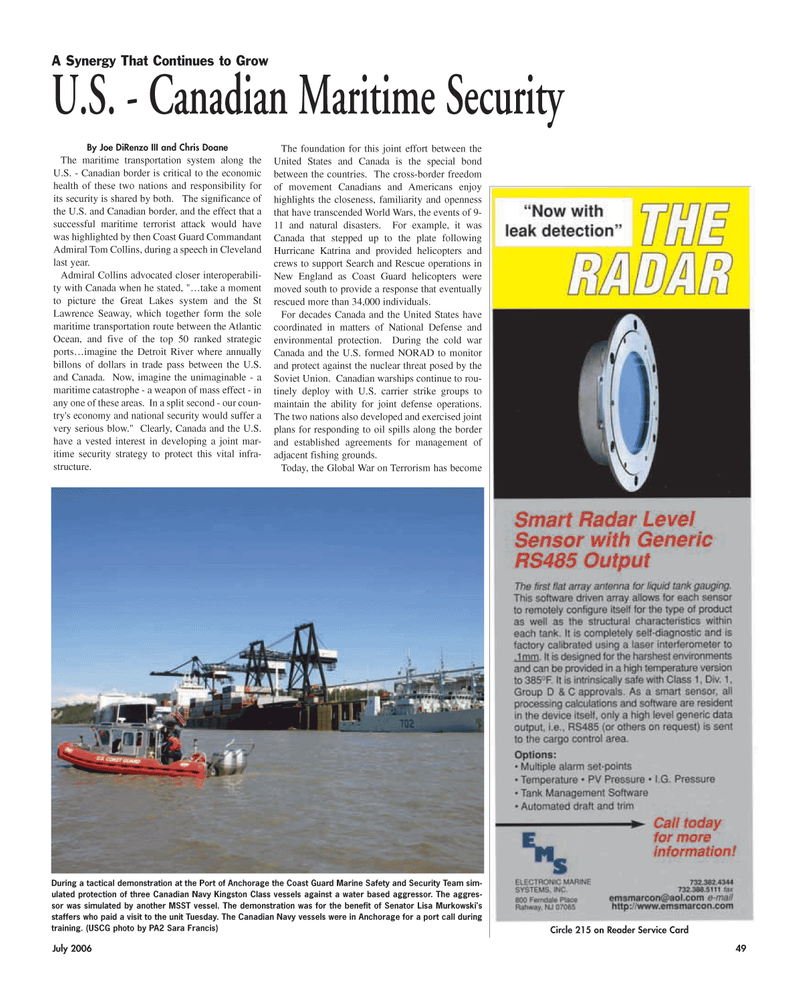
Page 49: of Maritime Reporter Magazine (July 2005)
The Satellite Communications Edition
Read this page in Pdf, Flash or Html5 edition of July 2005 Maritime Reporter Magazine
July 2006 49
By Joe DiRenzo III and Chris Doane
The maritime transportation system along the
U.S. - Canadian border is critical to the economic health of these two nations and responsibility for its security is shared by both. The significance of the U.S. and Canadian border, and the effect that a successful maritime terrorist attack would have was highlighted by then Coast Guard Commandant
Admiral Tom Collins, during a speech in Cleveland last year.
Admiral Collins advocated closer interoperabili- ty with Canada when he stated, "…take a moment to picture the Great Lakes system and the St
Lawrence Seaway, which together form the sole maritime transportation route between the Atlantic
Ocean, and five of the top 50 ranked strategic ports…imagine the Detroit River where annually billons of dollars in trade pass between the U.S. and Canada. Now, imagine the unimaginable - a maritime catastrophe - a weapon of mass effect - in any one of these areas. In a split second - our coun- try's economy and national security would suffer a very serious blow." Clearly, Canada and the U.S. have a vested interest in developing a joint mar- itime security strategy to protect this vital infra- structure.
The foundation for this joint effort between the
United States and Canada is the special bond between the countries. The cross-border freedom of movement Canadians and Americans enjoy highlights the closeness, familiarity and openness that have transcended World Wars, the events of 9- 11 and natural disasters. For example, it was
Canada that stepped up to the plate following
Hurricane Katrina and provided helicopters and crews to support Search and Rescue operations in
New England as Coast Guard helicopters were moved south to provide a response that eventually rescued more than 34,000 individuals.
For decades Canada and the United States have coordinated in matters of National Defense and environmental protection. During the cold war
Canada and the U.S. formed NORAD to monitor and protect against the nuclear threat posed by the
Soviet Union. Canadian warships continue to rou- tinely deploy with U.S. carrier strike groups to maintain the ability for joint defense operations.
The two nations also developed and exercised joint plans for responding to oil spills along the border and established agreements for management of adjacent fishing grounds.
Today, the Global War on Terrorism has become
Circle 215 on Reader Service Card
A Synergy That Continues to Grow
U.S. - Canadian Maritime Security
During a tactical demonstration at the Port of Anchorage the Coast Guard Marine Safety and Security Team sim- ulated protection of three Canadian Navy Kingston Class vessels against a water based aggressor. The aggres- sor was simulated by another MSST vessel. The demonstration was for the benefit of Senator Lisa Murkowski's staffers who paid a visit to the unit Tuesday. The Canadian Navy vessels were in Anchorage for a port call during training. (USCG photo by PA2 Sara Francis)
MR JULY2006 #7 (49-56).qxd 7/5/2006 12:05 PM Page 49

 48
48

 50
50
